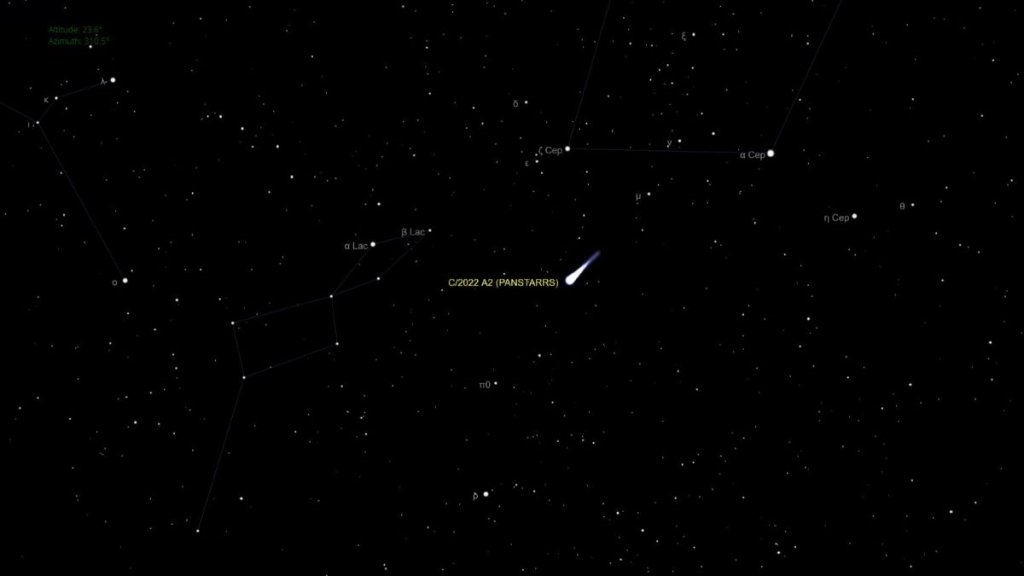
Watch a comet make its 1st and final pass by the sun this weekend (Image Credit: Space.com)
The comet C/2022 A2 (Pan-STARRS) will pass close by the sun on Sunday (Feb. 19), making its closest approach, or perihelion, when it will briefly be visible in the evening sky. This will be its first and final visit to the sun for the comet as the star’s gravity is expected to slingshot it out of the solar system.
According to In the Sky (opens in new tab) from New York City the comet will be visible from around dusk on Sunday. It will rise over the northwestern horizon at around 6:36 p.m. EST (2336 GMT) and it will be located in the constellation of Cygnus. C/2022 A2 (Pan-STARRS) won’t be visible for long, the comet will sink to just 20 degrees over the horizon at around 7:06 p.m. EST (0006 GMT).
Skywatchers will get a second brief chance to spot the comet as it passes close by the sun, the following day. On Monday (Feb. 20) C/2022 A2 (Pan-STARRS) will appear again, visible from New York at 4:17 a.m. EST (0917 GMT) before vanishing again at 5:39 a.m. EST (1039 GMT), just an hour before sunrise at 6:42 a.m. EST (1142 GMT). Interested skywatchers will need a large telescope to see C/2022 A2 (Pan-STARRS).
Related: Comets: Everything you need to know about the ‘dirty snowballs’ of space

Want a telescope to see bright comets? We recommend the Celestron Astro Fi 102 (opens in new tab) as the top pick in our best beginner’s telescope guide.
During the perihelion, C/2022 A2 (Pan-STARRS) will come to within will around 160 million miles (257 million km) of the sun, according to Cambridge University, (opens in new tab) which is 1.7 times the distance between the Earth and our star. The comet has an observed magnitude of 9.5 according to The Sky Live (opens in new tab). This means that the comet will probably only be visible with a large telescope, as it will be fairly dim in the night sky.
Not only will skywatchers have just a brief time to catch this comet during these two short windows of opportunity, but astronomers don’t think it will be back in the inner solar system.
This is because according to NASA Jet Propulsion Laboratory’s Small-Body Database (opens in new tab) C/2022 A2 (Pan-STARRS) is in a “hyperbolic orbit.” Comets on these orbits travel through the inner solar system just once because the sun acts as a gravitational slingshot, sending them hurtling out of the solar system.
All orbits can be defined by the “eccentricity” the amount a circle is flattened. A perfect circle has an eccentricity of 0, while hyperbolic comet orbits have an eccentricity greater than 1 — a shape called a hyperbola.
C/2022 A2 (Pan-STARRS) was first observed as part of the Pan-STARRS project in January 2022. In December of that year, astronomer Rob Matson spotted the comet in images and noticed that it is brightening more rapidly than expected.
Comets like C/2022 A2 (Pan-STARRS) brighten as they approach the sun. Radiation from our star heats the solid ice found on the comets, transforming it straight into gas through a process called sublimation. This ejects material from the comet causing its surrounding glow, known as the “coma,” and its characteristic cometary tail.
Though rapid brightening like this can indicate that a comet is unstable and is going to break up, C/2022 A2 (Pan-STARRS) lasted long enough to make a close approach to Earth, its perigee, on Jan. 17 before continuing on its one-way trip to the sun.
C/2022 A2 (Pan-STARRS) might be a tricky target, but there are plenty of other fascinating objects in the night sky worth viewing. If you’re hoping to catch a glimpse of comets or anything else in the night sky, our guides for the best telescopes and best binoculars are a great place to start. If you’re looking to snap photos of the night sky, check out our guide on how to photograph the moon, as well as our best cameras for astrophotography and best lenses for astrophotography.
Editor’s Note: If you manage to snap C/2022 A2 (Pan-STARRS) and would like to share it with Space.com’s readers, send your photo(s), comments, and your name and location to spacephotos@space.com.
Follow us @Spacedotcom, or on Facebook and Instagram.





